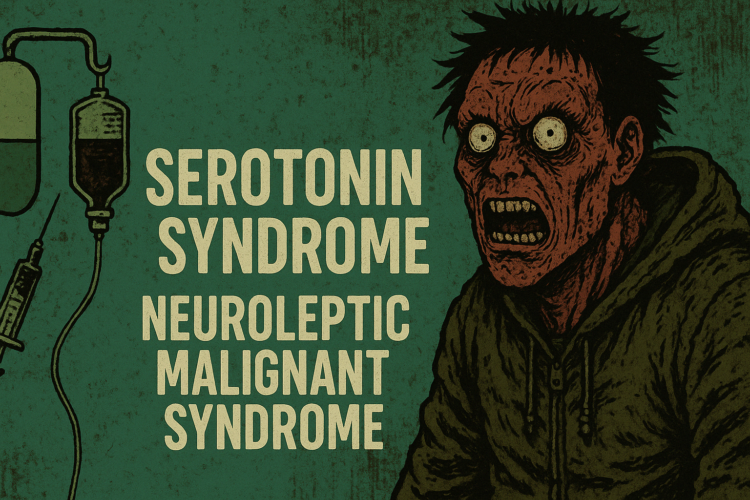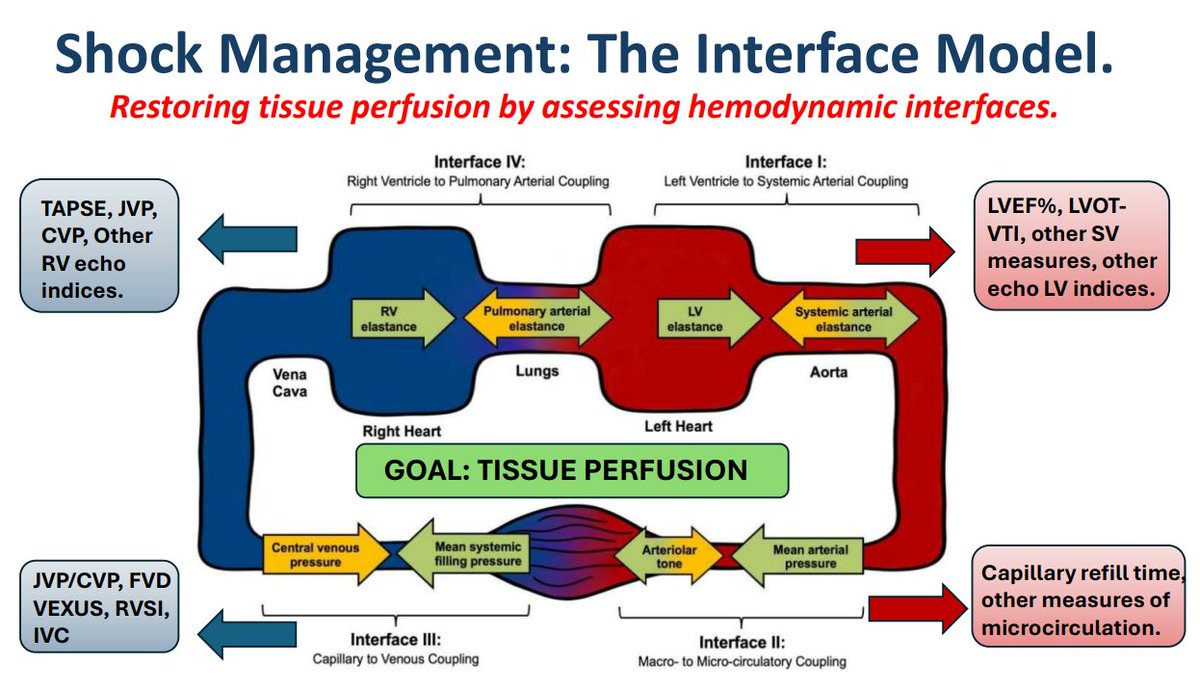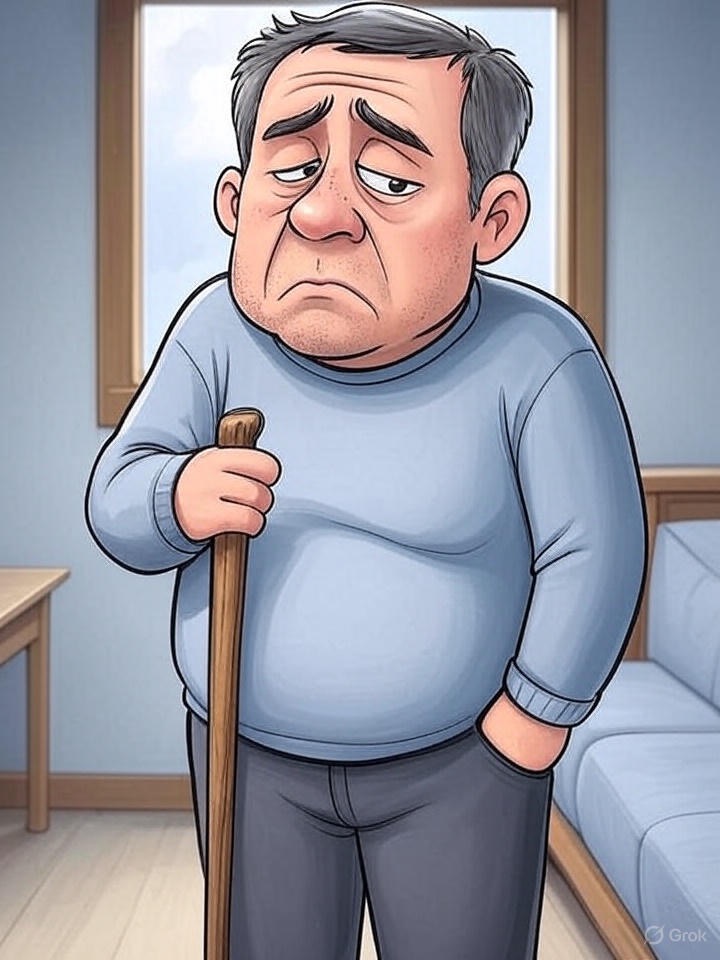So this week, neuroleptic malginant syndrome (NMS) and serotonin syndrome (SS). I do not have a burning desire to cover these two, but they are on the list and I must just take my medicine and get them over with. Now is the time, because next week, I’ll have Eelco Wijdicks on to discuss his take on NMS, so I need to get the primer over with.

To this table we should probably add Anticholinergic Toxicity which will have dry skin and decreased bowel sounds (in contradistinction to SS)
Serotonin Syndrome (SS)
Diagnosis
Serotonergic Drug(s) or Drug Interactions
Overdose of serotoninergic medications or interactions between medications that may cause an increase in serotoninergic activity
Serotonergic Agents
from Wijdicks et al. Mayo Clinic Critical and Neurocritical Care Board Review
Serotonin precursors or agonists
-
Tryptophan
-
5-HTP
-
SAMe
-
DHE
-
Triptans
-
LSD
-
5-MeO-DIPT
-
Lithium
-
Mirtazapine
-
Buspirone
Decreased serotonin reuptake
Serotonin reuptake inhibitors:
-
Fluoxetine
-
Paroxetine
-
Fluvoxamine
-
Sertraline
-
Citalopram
-
Escitalopram
-
Trazodone
-
Nefazodone
-
Vilazodone
Serotonin-norepinephrine reuptake inhibitors:
-
Duloxetine
-
Venlafaxine
-
Desvenlafaxine
-
Milnacipran
-
Atomoxetine
-
Sibutramine
Tricyclic antidepressants:
-
Amitriptyline
-
Nortriptyline
-
Clomipramine
-
Imipramine
-
Desipramine
-
Doxepin
Antiemetics:
-
Ondansetron
-
Granisetron
-
Metoclopramide
Others:
-
Dextromethorphan
-
Cyclobenzaprine
-
Chlorpheniramine
-
St John’s wort
-
Yohimbine
Decreased serotonin breakdown
Monoamine oxidase inhibitors:
-
Selegiline
-
Rasagiline
-
Phenelzine
-
Tranylcypromine
-
Isocarboxazid
-
Moclobemide
Antibiotics:
-
Linezolid
-
Tedizolid
-
Cycloserine
Others:
-
Methylene blue
-
Procarbazine
-
Syrian rue
-
Nutmeg
-
Ginseng
Opiates with mixed serotonin agonism
-
Tramadol
-
Tapentadol
-
Meperidine
-
Fentanyl
- Methadone
-
Pentazocine
-
Buprenorphine
-
Dextropropoxyphene
Stimulants with serotonergic activity
Drugs of abuse:
-
Amphetamines
-
MDMA
-
MDA
-
Cocaine
Anorectics:
-
Phentermine
-
Fenfluramine
-
Dexfenfluramine
-
Sibutramine
-
Amfepramone
Other agonists
Antipsychotics:
-
Risperidone
-
Olanzapine
-
Clozapine
Antiepileptics:
Peripheral inhibitors of metabolism
-
Fluconazole
-
Erythromycin
-
Ciprofloxacin
-
Ritonavir
Abbreviations: DHE, dihydroergotamine; 5-HTP, hydroxytryptophan; 5-MeO-DIPT, 5-methoxy-N,N-diisopropyltryptamine; LSD, lysergic acid diethylamide; MDA, methylenedioxyamphetamine; MDMA, 3,4-methylenedioxymethamphetamine; SAMe, S-adenosyl-L-methionine
Signs and Symptoms
Early presentation will have diaphoresis, myoclonus, and increased GI activity. Think sympathomimetic toxidrome + hyperreflexia + AMS.


Must have the presence of some medication combination to cause increased serotoninergic effects
S hivering, one of the neuromuscular symptoms unique to SS, helps distinguish it from other hyperthermic syndromes
H yperreflexia and myoclonus are frequently seen in mild to moderate cases and are especially notable in the lower extremities; muscular rigidity occurs only in more severe cases, in which case it is usually spasticity rather than the lead pipe rigidity of NMS
I ncreased temperature, although variable in SS and usually observed in severe cases, is likely caused by muscular hypertonicity
V ital sign instability can present as tachycardia, tachypnea, and/or labile blood pressure
E ncephalopathy—characterized by mental status changes such as anxiety, agitation, delirium, confusion, and to a lesser extent obtundation—can develop from hyperthermia
R estlessness and incoordination are common because of excess serotonin activity
S weating (diaphoresis) is an autonomic response to excessive serotonin stimulation; by comparison, anticholinergic toxicity usually manifests with hot, dry skin
from Christensen RC
3-Category Breakdown
Mental Status Changes
Sympathomimetic Effects
Muscle

Severity

Timing
Rapid Presentation 6-24 hours
Goes away or gets markedly better after 24 hours after medication changes
Scoring
Hunter Criteria
[10.1093/qjmed/hcg109]
Retrospective Study, sensitivity 84%, specificity 97%

SS is unlikely in the absence of either clonus (spontaneous or inducible) or tremor
Treatment
Stop Offending Agents
Stop anything that you can that has serotonergic effects
Sedate safely
- benzos or dexmedetomidine
Control the Temperature
- Benzos!!!
- Fans
- Cooling Devices
- Intubation +/- paralysis +/- Ice baths
Control the Muscle Rigidity
- Benzos
- Dantrolene-some would consider this, but I would only in the most extreme cases
Consider/Treat Rhabdomyolysis
- Send a CPK in any of these to check for rhabdo
- Give adequate IV fluids
Serotonin Blockers
- Speak to the housestaff about Cyproheptadine so they can get the question right on their boards. Cyproheptadine has very little evidence of effectiveness [10.1111/1742-6723.14554]
Great Papers on Serotonin Syndrome
More on EMCrit
Neuroleptic Malignant Syndrome (NMS)
Seen within 2-4 weeks of starting a new anti-psychotic, but illness may precipitate it even in chronic therapy
Median interval from drug to NMS is 4 days and the median duration of illness was 9 days. [39321364], but can occur up to 30 days after a drug has been administered
Anti-Psychotics (1st generation more than 2nd generation, and the latter may have milder symptoms)
Medications Associated with Neuroleptic Malignant Syndrome (From statpearls)
Typical Neuroleptics
-
Haloperidol
-
Chlorpromazine
-
Fluphenazine
-
Thioridazine
-
Trifluordazine
-
Thiothixene
-
Loxapine
-
Bromperidol
-
Promazine
-
Clopenthixol
Atypical Neuroleptics
-
Olanzapine
-
Clozapine
-
Risperidone
-
Quetiapine
-
Ziprasidone
-
Aripiprazole
-
Zotepine
-
Amisulpride
Antiemetics
-
Droperidol
-
Domperidone
-
Metoclopramide
-
Promethazine
-
Prochlorperazine
Others
-
Tetrabenazine
-
Reserpine
-
Amoxapine
-
Diatrizoate
-
Lithium
-
Phenelzine
-
Dosulepin
-
Trimipramine
-
Desipramine
Withdrawal of Dopaminergic Agents (can give a similar syndrome: Parkisonism-Hyperpyrexia Syndrome)
-
Levodopa
-
Amantadine
-
Tolcapone
-
Dopamine agonists
Presentation
Fever, muscular rigidity, and dysautonomia
- Exposure to a dopamine blocking drug
- Fever is usually high, >=40 C
- Some form of altered mental status from delirium all the way to catatonia
- Increased muscle tone progressing to rigidity. Lead pipe rigidity, referring to uniform resistance throughout range of limb. Can also be cogwheel with intermittent releases. Rigidity is less prominent with 2nd generation anti-psychotics
- Tachycardia and elevated, potentially labile blood pressure
Muscle rigidity and fever may lead to rhabdomyolysis (always send a CPK)
Absence of increased muscle tone effectively rules out NMS
Scoring
DSM-5 Criteria for NMS
Major Criteria (all required)
Other Criteria (at least two required)
-
Diaphoresis
-
Dysphagia
-
Tremor
-
Incontinence
-
Altered level of consciousness
-
Mutism
-
Tachycardia
-
Elevated or labile blood pressure
-
Leukocytosis
-
Elevated creatine phosphokinase (4x upper limit of normal)
Treatment
Discontinue offending medication
What to treat?
Blood pressure, hyperthermia and rhabdomyolysis from severe muscle rigidity, and potential respiratory compromise
Potential respiratory compromise
- Strongly consider intubating severe NMS
- Can give agents like glycopyrrolate to counter sialorrhea
Blood Pressure
- Short acting agents as the blood pressure can be labile
Hyperthermia
- Benzos
- Active cooling measures
Rhabdo
- Adequate IV fluids to maintain urine output
Sedation
- Dexmedetomidine
- Benzos
- Ketamine
Muscle Rigidity
- Benzodiazepenes
- Dantrolene-monitor LFTS. Initiate with a temp of 38-40 C and rigidity is moderate to severe
Dopamine Agonists (If on a board question)
ECT
to treat refractory cases, especially when having difficulty discerning from malignant catatonia
Papers on NMS
- Wijdicks & Ropper. NEJM 2024;391:1130
- Case Series of DSM-5 Criteria Diagnosed NMS Neurocrit Care [10.1007/s12028-024-02192-y]
More on EMCrit
Additional New Information
You Need an EMCrit Membership to see this content. Login here if you already have one.











